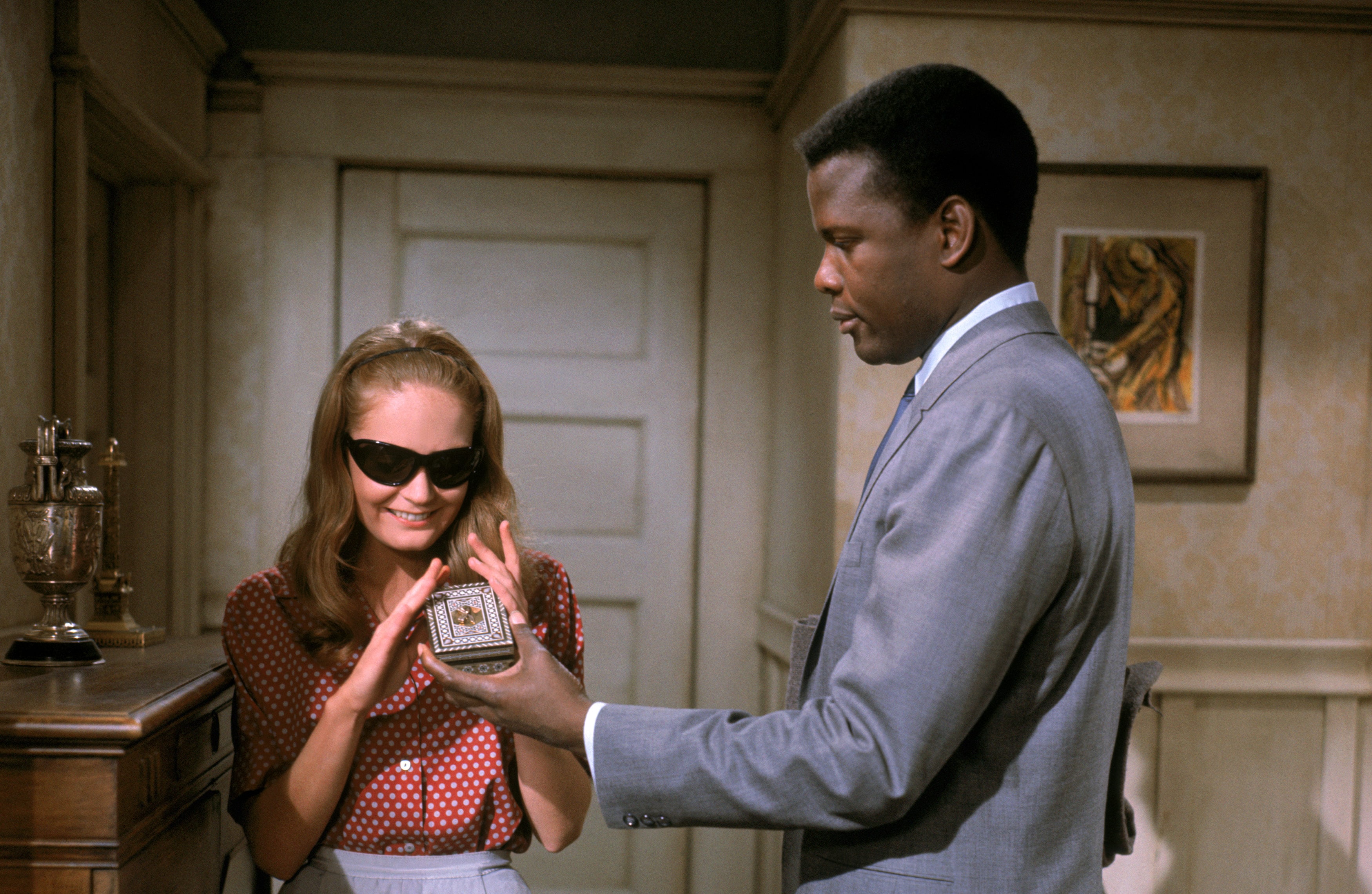A Patch of Blue

Brief Synopsis
Cast & Crew
Guy Green
Sidney Poitier
Shelley Winters
Elizabeth Hartman
Wallace Ford
Ivan Dixon
Film Details
Technical Specs

Synopsis
Selina D'Arcey, an 18-year-old girl accidentally blinded by her mother, Rose-Ann, in a family quarrel 13 years ago, lives in a shabby tenement with her prostitute mother and alcoholic grandfather, Ole Pa. She never leaves the apartment, has never attended school, knows nothing about braille, and spends her days cleaning, cooking, and stringing beads. When Ole Pa offers to take her to the park one morning and pick her up on his way home from work, Selina eagerly agrees. In the park she screams when a caterpillar lands on her shoulder, and Gordon Ralfe, a friendly young black man comes to her aid. They become friends, and Selina persuades Ole Pa to take her to the park every day. When Gordon introduces Selina to his brother Mark, Mark tries to discourage the couple's friendship. Then Sadie, an aging prostitute neighbor, sees the two together and tells Rose-Ann. Rose-Ann starts to beat Selina and tries to explain Gordon's racial difference, but Selina is unmoved. Gordon arranges to have Selina admitted to a school for the blind, a plan that interferes with Rose-Ann and Sadie's plan to start a whorehouse with Selina as a special attraction. Selina recalls to Gordon the last image she remembers seeing, a patch of blue sky, and tells him that one of her mother's customers raped her when she was 5 years old. Gordon insists upon removing her from the tenement into the school but will not marry her until she experiences other people and knows her mind more fully. Though Selina wants to marry Gordon, she heeds his advice and enters the school.

Director

Guy Green
Cast

Sidney Poitier

Shelley Winters

Elizabeth Hartman

Wallace Ford

Ivan Dixon
Elisabeth Fraser

John Qualen
Kelly Flynn
Debi Storm
Renata Vanni
Saverio Lomedico
Crew
Dorothy Aldrin
Ken Bell
Pandro S. Berman
Pandro S. Berman
Robert Burks
George W. Davis
Hal Davis
William R. Finnegan
Jerry Goldsmith
Henry Grace
Bill Graham
Guy Green
Guy Green
Larry Hadsell
Kathryn Hereford
Herb Hirst
Robert R. Hoag
George Hollister
Lloyd Isbell
Larry Jost
Urie Mccleary
Franklin Milton
Hank Moonjean
Bob Murdock
Rita Roland
Wesley Shanks
Leonard South
Charles Thompson
William Tuttle
Bruce Wright

Photo Collections
Videos
Movie Clip


Trailer
Hosted Intro





Film Details
Technical Specs

Award Wins
Best Supporting Actress
Award Nominations
Best Actress
Best Art Direction
Set Decoration
Best Cinematography
Best Score
Articles
A Patch of Blue
Once Poitier had committed to the project, he worked with Berman and writer-director Guy Green in updating the screenplay and making it more attuned to his onscreen personality. In the novel, the girl shares some of her mother's prejudices and reacts traumatically when she discovers the truth, pushing her newfound friend into the hands of racist vigilantes. "Nothing of that kind was left in the picture, the meaning of which depended on the fact that she did not mind discovering her friend's Negro origin," Berman commented. Thus, as re-envisioned by Poitier and his associates, the story takes on a much more optimistic tone; even though the friends eventually part, each has benefited from the relationship.
MGM tested 150 unknowns before signing Elizabeth Hartman as Poitier's costar. "I believe I was lacking the things they wanted an actress to lack," the Youngstown, Ohio native modestly commented to Sidney Skolsky at the time. The columnist observed that the 24-year-old Hartman was "shy, timid - She always takes her Raggedy-Ann doll to bed with her." Although she would appear in a half-dozen other films, Hartman grew increasingly reclusive with the years and died at 45 in a fall from her fifth-floor apartment, an apparent suicide.
Shelley Winters, cast as the monstrous mother, said in interviews that it was very difficult for her to speak the racial epithets used by her character in A Patch of Blue. "I've always found something to like in the characters I've played, but not this time," she said. "I really hate this woman." Despite her animosity toward the part, Winters won a Best Supporting Actress Oscar® for her shrewish performance. The film also was nominated in the categories of Best Actress (Hartman), Art Direction/Set Decoration, Black and White Cinematography and Original Score. Although neglected this time by Oscar, Poitier won a nomination for a British Academy Award as Best Foreign Actor.
A Patch of Blue proved a box-office winner, even in the South. In Atlanta, its first two weeks' grosses broke a record held by Gone With the Wind (1939). Old taboos still held, though; a modest, eight-second kiss between the leading characters was cut for Southern audiences. Poitier, meanwhile, had become frustrated by the limitations imposed upon his screen romances: "Either there were no women or there was a woman, but she was blind, or the relationship was of a nature that satisfied the taboos. I was at my wit's end when I finished A Patch of Blue."
Director: Guy Green
Producer: Pandro S. Berman, Guy Green, Kathryn Hereford (associate)
Screenplay: Guy Green, Elizabeth Kata (novel Be Ready With Bells and Drums)
Cinematography: Robert Burks
Music: Jerry Goldsmith
Art Direction: George W. Davis, Urie McCleary
Cast: Sidney Poitier (Gordon Ralfe), Shelley Winters (Rose-Ann D'Arcey), Elizabeth Hartman (Selina D'arcey), Wallace Ford (Ole Pa), Ivan Dixon (Mark Ralfe), Elisabeth Fraser (Sadie), John Qualen (Mr. Faber), Kelly Flynn (Yanek Faber)
BW-106m. Letterboxed. Closed captioning. Descriptive Video.
by Roger Fristoe

A Patch of Blue
Guy Green (1913-2005)
He was born on November 5, 1913 in Somerset, England. Long fascinated by cinema, he became a film projectionist while still in his teens, and was a clapper boy by age 20. He bacame a camera operator during World War II in such fine war dramas as One of Our Aircraft Is Missing; In Which We Serve (both 1942) and This Happy Breed (1944). His big break came as a director of photography came for Carol Reed's The Way Ahead (1944). He was eventually chosen by David Lean to photograph Great Expectations (1946), and his moody, corrosive look at Dickensian London deservedly earned an Academy Award. His work as a cinematographer for the next few years were justly celebrated. Film after film: Blanche Fury (1947), Oliver Twist (1948), The Passionate Friends (1949), Captain Horatio Hornblower R.N. (1951), The Beggar's Opera (1953), I Am a Camera (1955), all highlighted his gift for cloud-soaked period pieces with sweeping vistas of broad landscapes.
He made his directorial debut in a modest crime drama, River Beat (1954). Some minor titles followed: Portrait of Alison (1955); House of Secrets (1956); the ingenious mystery thriller The Snorkel (1958); the controversial child molestation drama The Mark (1961) starring Stuart Whitman in an Oscar® nominated performance; and his breakthrough picture, The Angry Silence (1960) which starred Richard Attenborough as an outcast who tries to battle labor union corruption. This film earned Green a BAFTA (a British Oscar equivilant) nomination for Best Director and opened the door for him to Hollywood.
Once there, he proceeded to make some pleasant domestic dramas: Light in the Piazza (1962), and Diamond Head (1963), before moving onto what many critics consider his finest work: A Patch of Blue (1965). The film, based on Elizabeth Kata's novel about the interracial love between a blind girl (Elizabeth Hartman) and a black man (Sidney Poitier) despite the protests of her bigoted mother (Shelley Winters), was a critical and commercial hit, and it earned Green a Golden Globe nomination for Best Director.
Strangely, Green would never enjoy a critical success equal to A Patch of Blue again. Despite his talent for sensitive material and handling of actors, Green's next two films: a forgettable Hayley Mills vehicle Pretty Polly (1967); and The Magus simply didn't attract the moviegoers or the film reviewers. He redeemed himself slightly with the mature Anthony Quinn-Ingrid Bergman love story Walk in the Spring Rain (1970); and the historical drama Luther (1973), before he stooped to lurid dreck with Jacqueline Susan's Once Is Not Enough (1975).
Eventually, Green would find solace directing a series of television movies, the best of which was an adaptation of the Arthur Hailey (of Airport fame) novel Strong Medicine (1986) starring Sam Neill and Annette O’Toole. Green is survived by his wife Josephine.
by Michael T. Toole
Guy Green (1913-2005)
Quotes
Only one thing messin' up your idea S'lina, and it ain't fatso's supper.- Ole' Pa
What then?- Selina D'Arcy
Nobody'd bring ya home.- Ole' Pa
You could. I can wait.- Selina D'Arcy
Many a time I'm not on my way till good and dark.- Ole' Pa
Is that all? Dark's nothing to me. I'm always in the dark.- Selina D'Arcy
I almost forgot. I'm out of detergent. Now this is where I really need your help. There's Swish...- Gordon Ralfe
"Keeps your hands soft as velvet."- Selina D'Arcy
Good. Whizz...- Gordon Ralfe
"Retains your girlish skin."- Selina D'Arcy
Marvelous. Jiffy...- Gordon Ralfe
What's happening now?- Selina D'Arcy
They're adding it all up.- Gordon Ralfe
In their heads?- Selina D'Arcy
No, on machines. They don't use heads anymore.- Gordon Ralfe
Trivia
Elizabeth Hartman wore a pair of opaque contact lenses that not only made her appear blind, but genuinely deprived her of her sight.
Contains the first black man-white woman lip to lip kiss on screen.
Patty Duke was offered the lead part of Selina D'Arcy. Patty Duke managers, John and Ethel Ross, did not want her to take the part because they felt that playing a blind person so close to the time she portrayed Helen Keller would stereotype her for future roles.
Miscellaneous Notes
Released in United States 1965
Broadcast in USA over TBS (colorized version) February 14, 1991.
Released in United States 1965














